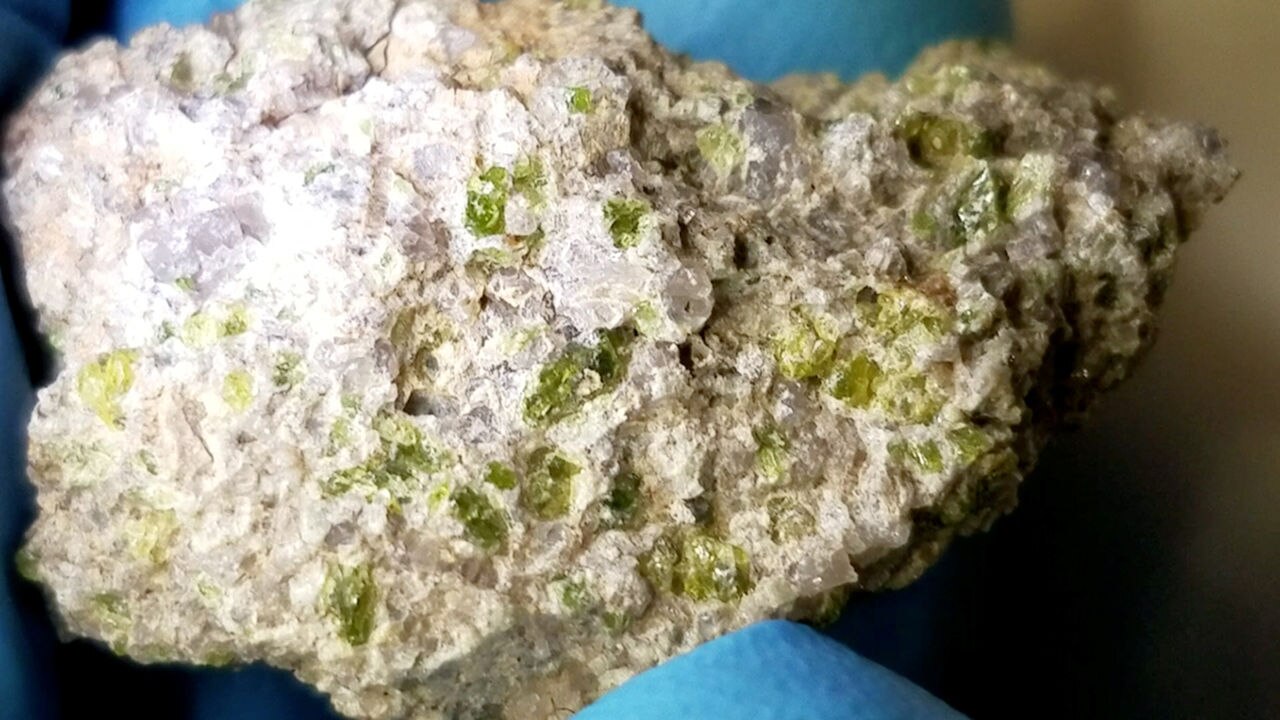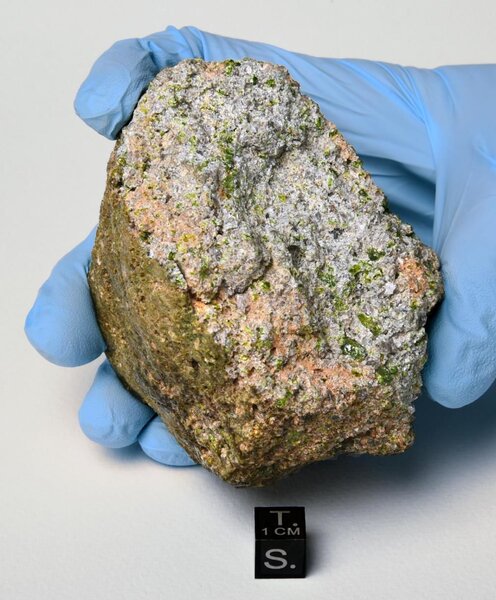Create a free profile to get unlimited access to exclusive videos, sweepstakes, and more!
A meteorite older than Earth shows evidence of ancient volcanism on a long-gone protoplanet

Sometimes, descriptions can be too simplistic. For example: Meteorites are bits of asteroids that fall to Earth.
While true, that's not the whole story. There are many kinds of asteroids; some are metallic, consisting of mostly iron and nickel, while others are "stony," being more like rock.
But there's stony, and there's stony. Planetary scientists have found the oldest igneous meteorite ever seen, and that's a record that will be hard to break. NWA 11119*, as it's called, has an age measured to be 4.5648 (± 0.0003) billion years old. When it formed, the Earth was still just a collection of rocks strewn around the Sun.
That in itself is cool but not really groundbreaking, since we've seen meteorites that are even older. But it's the fact that this is an igneous rock, forged in fire, that makes it remarkable. The minerals in it indicate it was formed via volcanism, a rock that was belched out of some ancient protoplanet's mantle onto its surface, where it cooled rapidly. This was not expected to occur that early on in the solar system, and it means we need to change some of the ways we think about that time.
Quick (and again overly simplistic) review: The solar system formed out of a cloud of gas and dust something like 4.6 billion years ago. The cloud flattened into a disk, and the Sun formed in the center. The planets formed out of the disk farther out. First microscopic grains of dust stuck together, randomly bumping and sticking to each other. These grew to pebbles, then boulders, eventually growing to objects over a kilometer in size. We call these planetesimals, and it's around that size that their own gravity can start to draw material onto them. These too would collide and stick, forming the nascent planets.
Impacts make these growing planetesimals hot, and molten throughout their interior. When it gets to a certain size, its gravity is strong enough that heavier stuff like iron and nickel starts to sink below the surface, while lighter materials like silicate (rock) float to the top. It forms a core, a mantle, and a crust — this process is called differentiation.
Conditions are different in those layers, and different minerals form. Mantles are where pyroxene† starts to form, a lovely crystal that is commonly green in color. On Earth, pyroxenes that form in the mantle get blurped up to the surface by volcanism.
Here's where things get fun. The meteorite NWA 11119 has lots of beautiful green pyroxene crystals in it, indicating it came from some ancient body big enough to get at least partially differentiated. Again, this isn't uncommon; pallasites are a type of meteorite that have olivine crystals (another mineral formed in the mantle) embedded in metal, for example (these may have formed deeper in planetesimals, near the mantle/core boundary).
But the rock itself is andesite, and that's the very strange part. Andesite is a light-colored volcanic rock that was thought to be unique to Earth, created in complicated geologic processes. Finding an example from a planetesimal is surprising, to say the least. The overwhelming majority of igneous meteorites are basaltic — a darker volcanic rock that has somewhat less silica in it (the surface of Mars is dominated by volcanic basalt, which is why its rocks are so dark gray in color).
The composition of NWA 11119 indicates that planetesimals, these small start-up planets, were undergoing complex geologic processes (including volcanism) when they were still relatively small, even before they started crashing together to form planets. And while it has similarities to other meteorites, the rocky part of NWA 11119 is unique, with a different composition than other igneous meteorites. It doesn't appear to have formed in the presence of water, for example, whereas andesites on Earth do. This hints at a different formation process. It may even indicate that this is the first known meteorite from that particular parent body, the planetesimal on which NWA 11119 formed.
Where is that planetesimal now? Certainly long gone. If it didn't become part of a planet or get ejected from the solar system totally, then it may have been destroyed in a collision, blasting it to bits. We know it suffered some impacts, at least, because that's how we got the meteorite in the first place. It was on the surface of the planetesimal when a big enough impact occurred to blow it into space on its own. Eventually, eons later, it fell to Earth.
A lot of our knowledge of the extremely early solar system comes from meteorites. Many formed before the planets did, and stayed in that state for all this time; these are like time capsules to the origin of the solar system. Others are clearly modified, formed inside bigger bodies. Some come from the Moon, and other planets! Normally we'd have to go to these other places to get samples of them (and we do do that), but in some cases, nature provides. It's a whole lot easier getting to northern Africa than it is to the regions of the solar system out past Mars to look for these samples … and the region you have to search is a whole lot smaller, too.
It's remarkable to me that this occurs at all! It's so wonderful that in so many things, our unquenchable curiosity can be at least partially sated, that some questions can be answered, because the clues we need are all around us. We're still learning about how the solar system put itself together to become the glorious structure we see today, and I'm delighted that we're able to figure it out at all.
*NWA stands for Northwest Africa. Lots of stony meteorites are classified as NWAs. But it's not that more fall there, it's that the area is dry and doesn't have a lot of sources of erosion, so rocky meteorites that fall there can be more easily found. So many come from there, in fact, that meteoriticists can't keep up with them all. NWA 11119, in particular, was found in Mauritania.
†CORRECTION (Sept. 7, 2019): For some reason I had originally written that the green crystals in the meteorite were olivine, when in reality they are pyroxene. I apologize for this error, and thank Moni Waiblinger in the comments for the note.



























